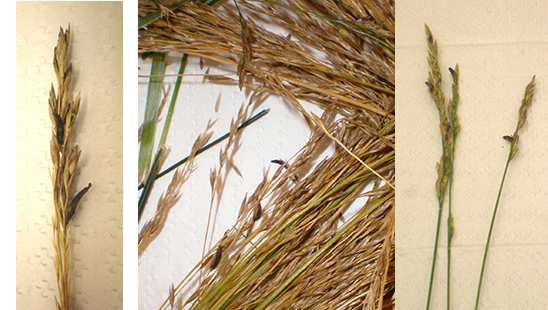Use caution when using rye straw for bedding
Use caution when using rye straw for bedding

Published on June 7, 2016
Due to a shortage of wheat straw in the United States, more and more equine operations are switching to rye straw for bedding. According to experts at the University of Kentucky’s College of Agriculture, Food and Environment, this is generally a good option, but there are several unique considerations with rye straw.
Unlike wheat, where the grain is harvested first and the remaining stems are cut and baled, with rye, the whole plant is usually harvested and baled. This means the seed heads are still on the plant. The seed heads of rye have awns or appendages that may cause gum irritation if the bedding is consumed. Watch horses closely when on rye bedding to make sure their gums are not becoming irritated.
Additionally, there can be molds that develop on the stems and seed heads of rye during wet harvest conditions. As with any hay or straw, make sure to only purchase bales that are clean and dust free.
The most important consideration with rye straw, however, is the risk of ergot. Ergot is caused by fungi and is poisonous to livestock when infected cereal grasses are consumed. In horses, the most common signs are lactation failure or deficiency, prolonged gestation and fertility problems. High doses of ergot alkaloids or prolonged exposures can also cause other signs such as gangrene of extremities.
Ergotfungal spores are found in the soil of much of the U.S. and infect the seeds of many grasses, particularly in wet springs. This infection results in the growth of sclerotia, also called ergot bodies, that look similar to mouse droppings instead of healthy seed. The sclerotia contain concentrated levels of many ergot alkaloids, a number of which are similar to the major toxin found in endophyte-infected tall fescue and cause symptoms similar to fescue toxicosis in mares.
Wheat straw is rarely infected with ergot, because the grains are removed prior to the straw harvest. Since most rye straw bales still contain the seed heads, ergot bodies are more likely to be present. Fortunately, even if ergot bodies are present, they usually fall off during the raking and baling process. However, horse owners and managers should inspect rye straw being used as bedding to ensure it is free of ergot bodies. If ergot bodies are found, the straw should not be used, as it often contains toxic concentrations of ergot alkaloids.
Horse owners and managers are asked to contact Ray Smith, forage extension specialist in the UK Department of Plant and Soil Sciences, at ukforageextension@uky.eduor 859-257-0597 or Cynthia Gaskill, veterinary clinical toxicologist at the UK Veterinary Diagnostic Laboratory at cynthia.gaskill@uky.eduor 859-257-7912 with any questions or concerns about ergotism. Additional information can be found at https://www.ag.ndsu.edu/pubs/plantsci/crops/pp551.pdf.
Ag Equine Programs


